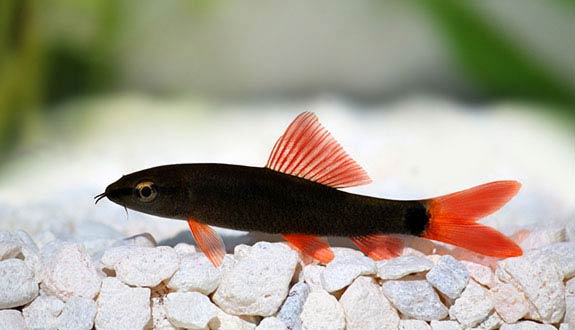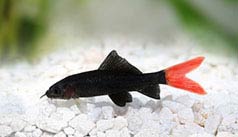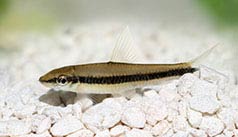

Alternative species (click on the thumbnail to see the card)
Names
Scientific name
Epalzeorhynchos frenatus
Labeo frenatus
Epalzeorhynchos
frenatum Labeo erythrura
Labeo erythruruss
Common name
Rainbow shark
Rainbow sharkminnow
Origin

Origin: Mekong Basin between Laos, Cambodia and Thailand
Biotope: Asian
Dimorphism

Presence of a black border on the anal fin of the male. The female is more imposing
Group

Cyprinidae
Volume

250 L / 55 imp gal / 66 US gal alone
800 L / 176 imp gal / 211 US gal in group
Parameters

T°: 22 to 26°C or 72 to 79°F
pH: 6 to 7
Hardness: 5 to 10°dGH
Difficulty

Average
Size

10 to 15 cm (4 to 5.9")
Longevity

10 years
Living zone

Middle and depth
Individuals

1 or 5/6
Food
How to feed the Rainbow shark?
Food
How to feed the Rainbow shark?
Omnivorous: all forms of food are accepted with plant supplements (spinach, cucumber, zucchini, peas shelled for example).
Behavior
What kind of behavior does the Rainbow shark have?
Behavior
What kind of behavior does the Rainbow shark have?
It is the most peaceful of the 4 species of Epalzeo, but it nevertheless remains classified in the category of aggressive and territorial fish. Lively and active, it must absolutely not cohabit with calm or shy fish. Finally, its strong temper is more a very developed sense of the territory.
When the aquarist understands its territorial rules and takes them into account, the Rainbow sharkminnow is a fish that will live its life peacefully.
Cohabitation
Who can live with the Rainbow shark?
Cohabitation
Who can live with the Rainbow shark?
The Rainbow shark will be a better choice for a community aquarium than the Redtailed Labeo. However, its roommates must also be carefully chosen.
Indeed, the species that resembles it are to be avoided (other Epalzeorhynchos, Crossocheilus, Balantiocheilus, Garra, Gyrinocheilus). On the other hand, it seems less belligerent towards the grouper (Botia, Syncrossus, Yasuhikotaki, Chromobotia), and only tolerates the presence of its congeners in large volumes (5/6 individuals in 800 L or 210 gal).
In a large aquarium (500 L or 130 gal), it can cohabit with large Cichlids with a strong temper, or with some very lively species such as Puntigrus tetrazona (Sumatra barbs), Etroplus or Danios.
You will understand, all your population will turn around this particular fish!
Breeding
How to breed the Rainbow shark?
Breeding
How to breed the Rainbow shark?
Very difficult, even if the breeding of this species remains more feasible than that of Redtailed Labeo. Identical procedure: place in a spawning tank (200 L or 50 gal) composed of numerous hiding places and plant tuft, 1 male and 1 female. Temperature 24/27°C or 75/80°F and pH at 6.5/7. Install a powerful filtration that will generate a large current. The lighting will be dimmed. Spawning takes place within 24 hours. A laying may include up to 1000 eggs. The incubation lasts 36 hours. From the age of one month, add vegetable supplements to their food.
Fry food: infusoria, then nauplies of artemia and cyclops.
Its aquarium
Which aquarium for the Rainbow shark?
Its aquarium
Which aquarium for the Rainbow shark?
The Rainbow shark is not very demanding as for its decoration. However, it seems happier in an aquarium composed of fine sand, luxurious vegetation, driftwood root, some rocks of different sizes and floating plants to sift the lighting. Finally, install a moderate current.
Good To know
Find all additional information!
Good To know
Find all additional information!
The special temper of the Rainbow shark makes it a fish reserved for experienced aquarists.
Do not buy it as an «algae eater» because you may have big problems with your existing population. Prefer the Crossocheilus which are much better eater of seaweed.
The albino variant of this species seems less aggressive.
Yours photos!
Comments
Sort by:
Please login to post comments



